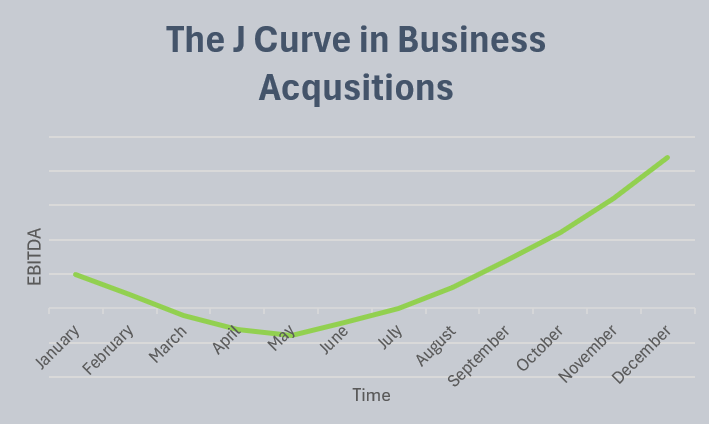
Buying a Business? Here’s Why the J Curve Matters More Than You Think
Chris Barrett
What Is the J Curve in Business Acquisition?
The J Curve in business acquisition is a financial concept illustrating the typical earnings trajectory following a company purchase. Visualized as a “J”-shaped graph, it highlights an initial decline in profitability—usually EBITDA—immediately after the acquisition, followed by a gradual, sustained recovery and growth.
For business buyers, this curve reflects the natural financial turbulence that occurs before long-term value is realized.
Why the Dip Happens: Common Causes Behind the Downturn
1. Transaction Expenses
Legal, advisory, and due diligence fees add up quickly. These costs, although necessary, offer no immediate ROI and temporarily weigh down earnings.
2. Operational Changes
Changes in leadership, staffing, or structure can cause short-term disruption. Integrating new systems or processes can be time-consuming and resource-intensive.
3. Capital Investments
New owners often invest in technology upgrades, facility improvements, or marketing. These capital expenditures don’t yield immediate returns but set the stage for future growth.
4. Cultural and Structural Integration
Merging corporate cultures or adapting to a new management style can cause temporary slowdowns as employees adjust.
What Drives the Rebound: Climbing the Upward Curve
Combined operations often create cost savings or improved efficiencies. These synergies boost margins and streamline operations.
2. Revenue GrowthWith the right investments, the acquired business may tap into new customer bases, improve product offerings, or scale marketing strategies.
3. Fixed Costs Stay StableAs revenue increases, many fixed costs—like rent, salaries, and insurance—remain consistent, boosting overall profitability.
4. Team Morale ImprovesSuccessful integration boosts confidence across the company, improving productivity and retention.
Strategies to Successfully Navigate the J Curve
Understand the financial health, market position, and operational gaps before signing. Anticipating pitfalls makes them easier to manage post-acquisition.
Create an Integration RoadmapHave a well-structured, time-bound integration plan. Assign leaders, set milestones, and communicate consistently.
Build a Financial CushionPrepare for the dip. Maintain reserves to cover upfront costs and keep operations stable through the transition.
Manage Stakeholder ExpectationsClearly communicate timelines and challenges with investors, employees, and partners. Transparency builds trust and buy-in.
Conclusion: Embrace the J Curve for Long-Term Gains
The J Curve in business acquisition will feel like a setback—but if properly prepared for it’s a setup for future success. Recognizing and preparing for this curve equips buyers to make smarter decisions, stay patient, and unlock long-term value.
🎥 Watch: Understanding the J Curve in Business Acquisitions
Prefer video? In this short explainer, I break down the key phases of the J Curve in business acquisition, including why profits dip and how to position for long-term growth. Watch it on YouTube here.
Frequently Asked Questions
Most J Curves last between 12 to 24 months, depending on the industry, scale of acquisition, and integration effectiveness.
Not entirely, buying a business will always cause changes to occur that will result in some disruption. However, strategic planning, efficient integration, and clear communication can significantly reduce the dip’s impact and duration.
While not universal, it is a highly observed pattern in business acquisitions, especially where significant changes or investments are involved. We highly recommend that you build this dip into your projections.

Disclaimer
The content contained in this blog post is intended for general informational purposes only and is not meant to constitute legal, tax, accounting, or investment advice. You should consult a qualified legal or tax professional regarding your specific situation.
